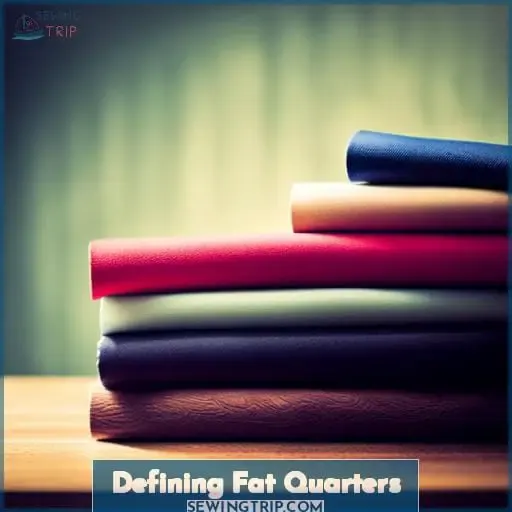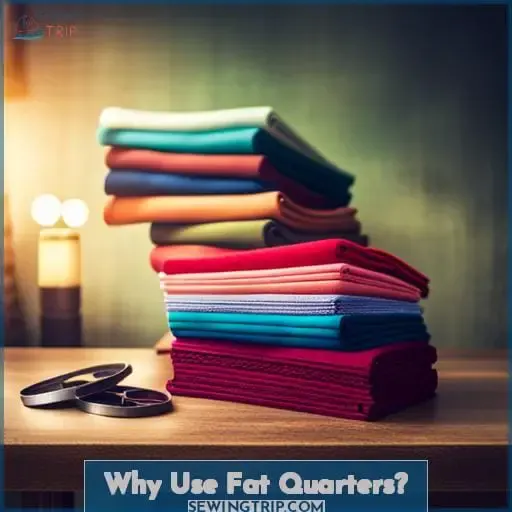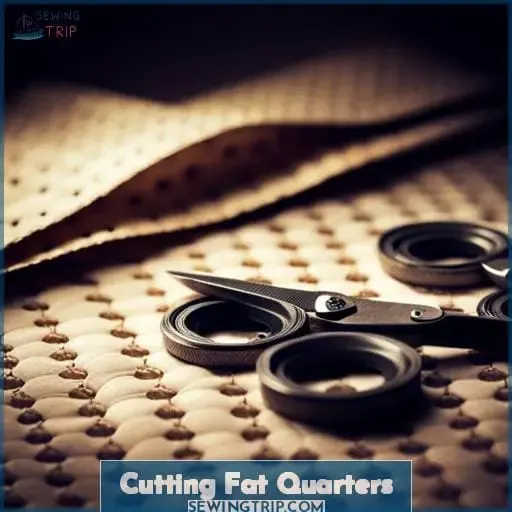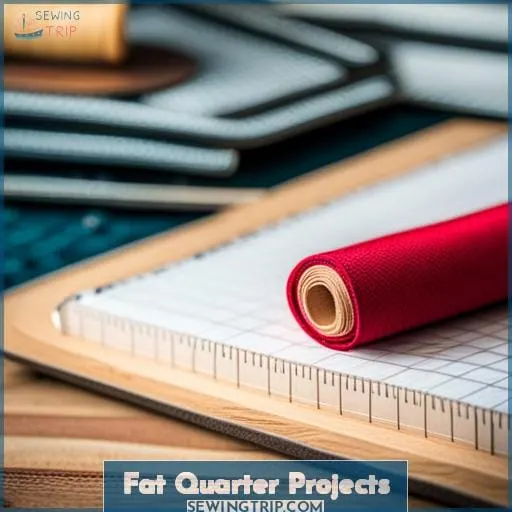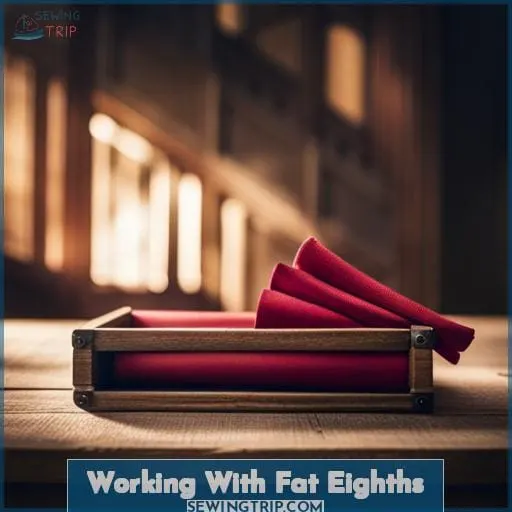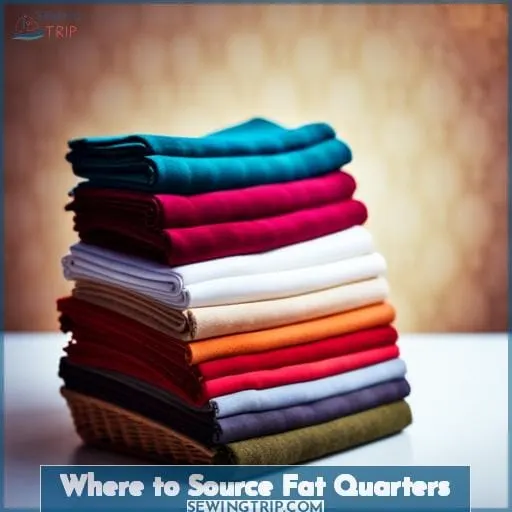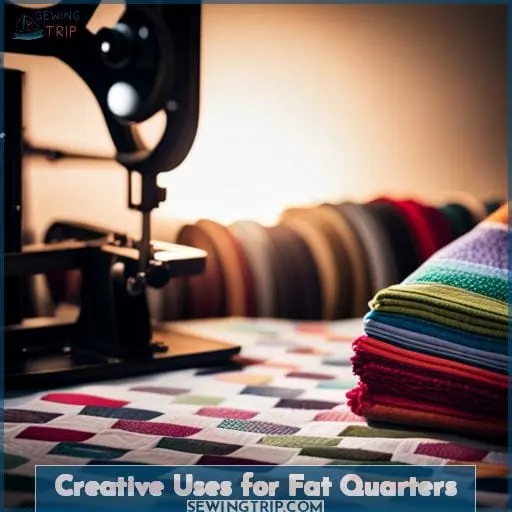This site is supported by our readers. We may earn a commission, at no cost to you, if you purchase through links.
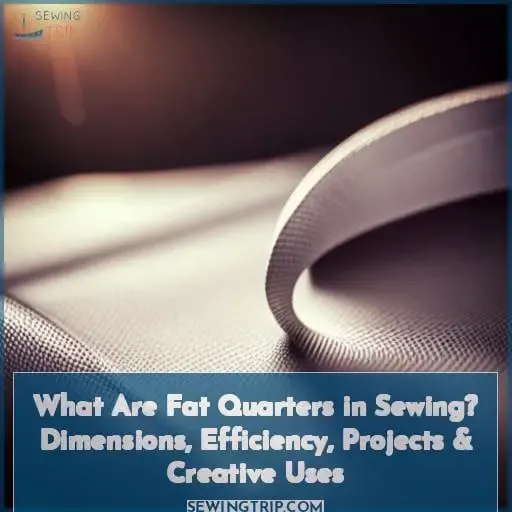 Like a patchwork quilt, fat quarters stitch together scraps into something beautiful.
Like a patchwork quilt, fat quarters stitch together scraps into something beautiful.
Their compact shape fills spaces regular quarters can’t, letting you cut more pieces and saving your stash.
Embrace their possibilities – these friendly cuts fit together to create quilts, bags, decor, and more, their colors and patterns welcoming you home.
What dreams will you sew?
Table Of Contents
Key Takeaways
- Fat quarters offer more usable width for cutting shapes and strips compared to standard quarter yard cuts
- Fat quarters provide cost and yardage savings by requiring less fabric and fewer seams for projects
- The dimensions of fat quarters allow for efficient cutting of pattern pieces to reduce waste
- Common sewing projects using fat quarters include quilts, bags, pillows, and other home decor items
Defining Fat Quarters
When sewing with fat quarters, first understand how they differ dimensionally from standard quarter-yard cuts.
Typically, fat quarters measure about 18 by 21 inches, while regular quarters are 9 by 42 inches when cut from wider bolts.
Comprehending the unique size and shape of fat quarters allows you to utilize them more efficiently in your projects.
Dimensions
You’re often working with fat quarters cut to about 18 by 22 inches, which is larger than standard quarter yards.
These wider rectangles measure around 45 by 55 centimeters and offer more fabric area than regular quarter-yard cuts, with 1 yard yielding 4 fat quarters.
The added width facilities efficient strip piecing and quilt block construction.
Compared to Standard Quarters
When you compare them to standard quarter yards, fat quarters give you more usable width for cutting shapes and strips.
With their wider dimensions, fat quarters yield more squares and strips from the same amount of fabric.
Their compact shape also makes them easier to handle.
Despite the same price, you get more usable fabric in a fat quarter.
With versatile dimensions suitable for many projects, these convenient, pre-cut quarters minimize waste.
Why Use Fat Quarters?
Fat quarters offer quilters and sewers distinct advantages in crafting efficiency and cost savings. Their unique dimensions allow for versatile use across sewing projects while reducing fabric waste. Let’s examine the specifics of how fat quarters can optimize your budget and creative options.
Efficiency
You can make the most of your fabric purchases when using fat quarters since they provide versatile dimensions without requiring large cuts.
Fat quarters offer wider pieces from the bolt without excess length, allowing you to get more varied fabric options while minimizing waste.
With fewer seams and less fabric cutting needed, fat quarters streamline projects using less yardage overall.
| Fabric Cut | Dimensions | # needed for 1 yard |
|---|---|---|
| Fat Quarter | 18 x 21 | 4 |
| Standard Quarter | 9 x WOF* | 4 |
*WOF = Width of Fabric
Cost
Because fat quarters provide the same amount of fabric as traditional quarter yard cuts but offer greater flexibility in cutting and pattern layout, you can often save money by purchasing fat quarters instead when sewing smaller items or projects requiring more varied fabric pieces.
- Lower cost per usable inch
- More fabric variety
- Less waste from odd cuts
- Better value from fat quarter bundles
- Versatile for your fabric stash
Cutting Fat Quarters
After learning about the efficiency and cost benefits of fat quarters, you’re ready to start cutting them.
- A rotary cutter
- A cutting mat
- A ruler
When cutting, pay attention to fabric grainlines and nest pieces to maximize usage.
| Tool | Purpose |
|---|---|
| Rotary cutter | Smooth cutting along edges |
| Cutting mat | Protects work surface |
| Ruler | Guides straight cuts |
Nesting involves positioning pattern pieces to minimize fabric waste. When cutting fat quarters specifically, you can obtain pieces needed for projects without purchasing full yardage. Their convenient size and shape lend well to efficient cutting. With proper tools and technique, fat quarters provide versatility in crafting.
Fat Quarter Projects
Fat quarters can be used for various sewing projects.
Quilts and bags are common creations made with fat quarters, allowing for diverse fabrics and creative layouts.
You can also use them to make home decor items like pillows, placemats, curtains, and other crafts.
Quilts
The fat quarter’s versatility allows you to construct various types of quilts, from simple patchwork to more intricate geometric patterns. Its ample size lends well to both beginner-friendly quilts like squares or strips as well as advanced patterns incorporating diverse fabrics.
With proper planning, fat quarters enable beautiful quilts using less yardage—their accessibility empowers your creativity. Consider working through quilting levels using fat quarters to minimize waste while discovering enjoyable techniques.
Bags
You’ll often craft bags from fat quarters for their efficiency and creative versatility.
- Bag patterns like totes, purses, or pouches
- Bag tutorials on YouTube or blogs
- Sturdy bag fabrics like canvas or denim
- Coordinating bag linings
- Hardware like zippers, clasps, or straps
Home Decor
With fat quarters, you can fashion chic throw pillows, striking curtains, and snazzy tote bags. Crafting home decor with fat quarters allows for personalized styling like pillows, curtains, wall hangings, and storage solutions while avoiding fabric distortion.
| Project | Fabric Needed |
|---|---|
| Pillows | 2-4 fat quarters |
| Curtains | 6+ fat quarters |
| Wall Hanging | 3 fat quarters |
| Storage Bins | 2 fat quarters |
Working With Fat Eighths
In contrast to fat quarters, you’d be working with skinnier yet longer fat eighth cuts when starting out with a quarter yard.
These 9 x 21 rectangles offer versatility in projects requiring shorter strips or binding while conserving fabric.
Take care when cutting fat eighths to position rulers precisely, using a rotary cutter across the full width to get straight edges.
Align fabric accordingly between selvage edges for efficient repeated cuts.
Fat eighth precuts mean avoiding cutter work yet offer less coordination in fabric patterns.
Fold fat eighths to prevent distortion and store in sealable bags by project or color scheme.
Though narrower, incorporate creative fat eighth uses into sewing patterns like mini quilts, doll clothes, hair scrunchies, or placemats.
The scaled-down size allows first-timers to hone skills before graduating to fatter quarters.
Where to Source Fat Quarters
Quilt shops carry the best selection of fat quarters for any sewing project. You’ll find a wider variety of prints, solids, batiks, and other specialty fabrics perfect for all your quilting and sewing needs.
Many shops also offer pre-cut fabric packs containing coordinating fat quarters, making project planning easier.
Beyond the selection, visiting a local quilt shop provides opportunities to connect with and learn from experienced staff and fellow sewing enthusiasts in person.
Even if you source most supplies online, consider stopping into a quilt shop now and then to see new fabrics and patterns or to simply soak in the creative energy. And you never know what unique fat quarter might catch your eye for your next quilted masterpiece or gift project.
Checking out the shops’ websites for samples of current fabric lines can also help guide your online fat quarter shopping.
Creative Uses for Fat Quarters
Seven creative ways you’re utilizing fat quarters include:
- Making quilted pouches
- Stuffing animals
- Friendship bracelets
- Hair scrunchies
- Doll clothes
- Needle cases
- Embroidered patches
Further creative endeavors with fat quarters include:
- Coasters
- Pillows
- Aprons
- Skirts
- Dresses
With their versatile dimensions, fat quarters enable small and decorative projects like coasters, along with larger efforts like pillows and aprons.
Overall, fat quarters empower diverse creative expressions, from miniature crafts to full-sized garments. Their convenience, variability, and availability facilitate such creative freedom.
Frequently Asked Questions (FAQs)
How many fat quarters do I need for a baby quilt?
Typically 8-12 fat quarters will sufficiently cover a baby quilt, depending on the pattern and size of the quilt.
Look for a pattern that fits your skill level and aesthetic, then purchase the requisite number of coordinating fat quarters.
Layer, assemble, quilt, and bind with care to create a meaningful heirloom.
Can I use fat quarters in clothing projects besides quilts?
Yes, you can use fat quarters for clothing like dresses, skirts, tops, and accessories. Their dimensions work well for many patterns beyond just quilts. Get creative with these versatile precut pieces.
What’s the difference between a charm pack and a fat quarter bundle?
A charm pack contains 5 squares from various fabric designs, while a fat quarter bundle has 18 x 21 cuts of fabrics, offering longer pieces to work with for projects beyond just squares.
Are there any quick and easy fat quarter projects for beginners?
Yes, try easy fat quarter projects like:
- Pouches
- Coin purses
- Pillows
- Microwave bowl cozies
Simply search for beginner fat quarter patterns free to find straightforward designs you can sew up quickly without much fabric or fussy cutting.
Focus on small accessories first to build skills.
What are some good online retailers to buy fat quarter bundles from?
When searching for fat quarter bundles, reliable online retailers like Missouri Star Quilt Company, Fat Quarter Shop, and Connecting Threads offer ample options at reasonable prices.
Peruse their selections to find diverse designs suiting your creative visions.
Conclusion
As you piece together this collage of fabric snippets, watch your creation unfold with delight.
Each fragment finds its place, distinct pieces fused into a warm, welcoming whole.
Let imagination guide your hands to form something wonderful from remnants too small alone, now stitched as one.
What visions will you craft from these fabric scraps, their friendly cuts and colors inspiring homespun dreams?
Embrace the possibilities of your fat quarters.

